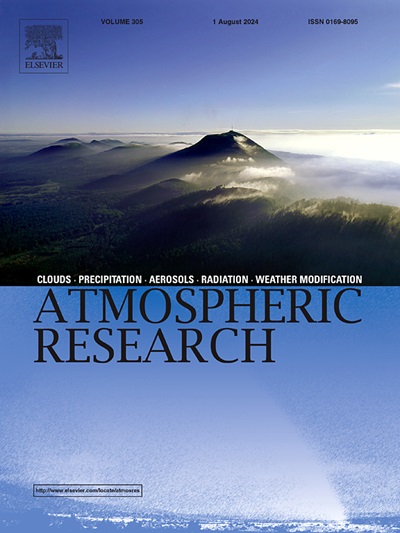Responses of atmospheric inorganic nitrogen deposition to emissions in a polluted region of southern China
IF 4.4
2区 地球科学
Q1 METEOROLOGY & ATMOSPHERIC SCIENCES
引用次数: 0
Abstract
Human-induced nitrogen (N) emissions have enhanced atmospheric N deposition in many polluted regions. However, the spatiotemporal relations between N emissions and deposition remain poorly characterized, which hampers N emission management and effect evaluation in polluted regions. This study investigated dry and wet inorganic N (IN) deposition at representative urban and suburban sites from June 2018 to May 2019 and analyzed historical N emission and deposition data in a N-polluted region of southern China. Dry, wet, and total IN deposition were 14.1 and 6.3, 36.4 and 29.0, and 50.5 and 35.3 kg N ha−1 yr−1 at the urban and suburban sites, respectively. Gaseous N accounted for 79–87 % of dry IN deposition and dry deposition accounted for 18–28 % of total IN deposition. The inter-annual variation of wet IN deposition exhibits an inverted “V” shape: the turning point for ammonium (NH4+) was in 1991 due to the decline in the ratio of ammonia to sulfur dioxide and nitrogen oxide and ammonia emissions; nitrate (NO3−) peaked in 2010, reflecting the benefits of national controls on nitrogen oxide emissions. Consequently, a shift to approximately equal NH4+ and NO3− deposition occurred in 2010–2020. Spatially, annual IN deposition increased with human-induced land use and N emissions, and about 30 % of the area exceeded the critical load for N deposition. Current emission controls are reducing N emissions and deposition but further mitigation measures are needed, especially broader regional strategies.

华南某污染地区大气无机氮沉降对排放的响应
在许多污染地区,人为氮排放增加了大气氮沉降。然而,氮素排放与沉积的时空关系尚不清楚,这给污染地区氮素排放管理和效果评价带来了阻碍。本研究调查了2018年6月至2019年5月中国南方某氮污染地区代表性城市和郊区干湿无机氮(IN)沉降情况,并分析了历史N排放和沉降数据。干氮、湿氮和总氮在城市和郊区分别为14.1和6.3、36.4和29.0、50.5和35.3 kg N ha−1 yr−1。气态氮占干态氮沉积的79 ~ 87%,干态氮占总氮沉积的18 ~ 28%。湿态氮的年际变化呈倒“V”型,其中氨(NH4+)的拐点出现在1991年,这是由于氨与二氧化硫和氮氧化物的比值下降以及氨排放量减少所致;硝酸盐(NO3−)在2010年达到峰值,反映了国家控制氮氧化物排放的好处。因此,在2010-2020年,NH4+和NO3−的沉积发生了大致相等的转变。在空间上,随着人类土地利用和氮排放的增加,年氮沉降量增加,约30%的区域超过了氮沉降的临界负荷。目前的排放控制措施正在减少氮的排放和沉积,但需要进一步的缓解措施,特别是更广泛的区域战略。
本文章由计算机程序翻译,如有差异,请以英文原文为准。
求助全文
约1分钟内获得全文
求助全文
来源期刊

Atmospheric Research
地学-气象与大气科学
CiteScore
9.40
自引率
10.90%
发文量
460
审稿时长
47 days
期刊介绍:
The journal publishes scientific papers (research papers, review articles, letters and notes) dealing with the part of the atmosphere where meteorological events occur. Attention is given to all processes extending from the earth surface to the tropopause, but special emphasis continues to be devoted to the physics of clouds, mesoscale meteorology and air pollution, i.e. atmospheric aerosols; microphysical processes; cloud dynamics and thermodynamics; numerical simulation, climatology, climate change and weather modification.
 求助内容:
求助内容: 应助结果提醒方式:
应助结果提醒方式:


